When you accidentally delete an email message in Outlook, you can recover the message if it's still in your Deleted Items folder. In some cases, you can even recover items after the Deleted Items folder is emptied.
You can also recover a deleted folder (with all of its messages) if it's still in your Deleted Items folder. Unfortunately, you can't recover a folder that's been permanently deleted. But you can use the steps in this topic to recover messages that were in a folder when it was permanently deleted.
Note: Sign into Outlook using your Microsoft 365 work or school account.
Note: If the instructions don't match what you see, you might be using an older version of Outlook on the web. Try the Instructions for classic Outlook on the web.
When you delete an email message, a contact, a calendar item, or a task, it's moved to the Deleted Items folder. If you don't see a message in the Deleted Items folder, check the Junk Email folder. Contents of deleted folders are only visible once you expand the Deleted Items folder.
-
In the left pane, select the Deleted Items folder or the Junk Email folder.
-
Do one of the following:
-
Deleted Items folder: Select the message you want to recover and select Restore.
Notes:
-
You can't restore messages that have been deleted from your Deleted Items folder.
-
Messages that were in a deleted folder can only be restored by selecting Move to and choosing a folder that's not been deleted.

-
-
For New Outlook for Windows, right-click the message you want to recover and select Restore.
-
Junk Email folder: Select the message you want to recover and select Not junk.
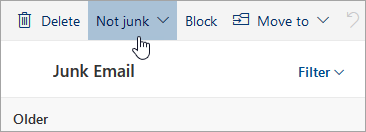
-
For New Outlook for Windows, select the message you want to recover and select It's not junk.
-
If you can't find an item in the Deleted Items folder, the next place to look is the Recoverable Items folder.
-
In the left pane, select the Deleted Items folder.
-
At the top of the message list, select Recover items deleted from this folder.

-
Select the items you want to recover and select Restore.
Where do recovered items go? The items you select to recover will be restored to their original folders when possible. If an original folder no longer exists, items will be restored as follows:
-
Messages go to your inbox.
-
Calendar items go to your calendar.
-
Contacts go to your contacts folder.
-
Tasks go to your tasks folder.
Outlook may empty your Deleted Items folder each time you sign out. To change this:
-
At the top of the page, select Settings .
-
Select Mail > Message handling.
-
Under When signing out, uncheck the box next to Empty my deleted items folder.
Instructions for classic Outlook on the web
When you delete an email message, a contact, a calendar item, or a task, it's moved to the Deleted Items folder in your mailbox. If you're trying to find a message that was deleted, the Deleted Items folder is the first place to look. If the message is there, here's how to recover it:
-
In your email folder list, select Deleted Items and do one of the following:
-
To restore a message to its original folder, right-click the item and then select Recover.
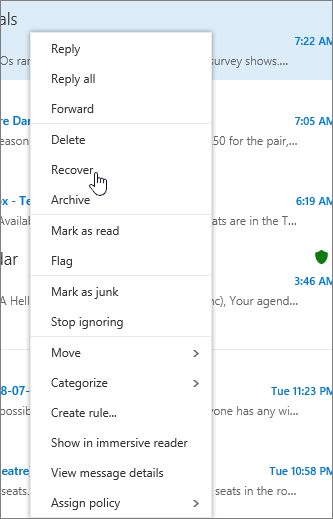
-
To restore a message to a different folder, right-click the item, and select Move > Move to a different folder. Next, specify a folder location, and then select Move.
-
Tip: If you delete a folder, it's moved to the Deleted Items folder and appears as a subfolder. To recover it (and all the items it contains), right-click the deleted folder, click Move, and then select a folder to move it to.
If you can't find an item in the Deleted Items folder, the next place to look is the Recoverable Items folder.
-
In the left pane of the Outlook on the web window, select the Deleted Items folder.
-
At the bottom of the window, select Recover deleted items.

-
Select the item you want to recover, and then select Recover from either the toolbar

or from the Reading pane.
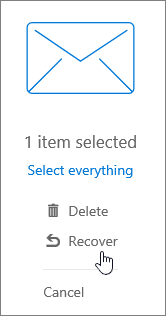
-
In Recover items, select OK.
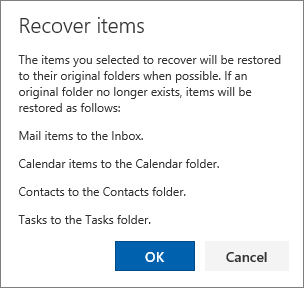
Where do recovered items go? The items you select to recover will be restored to their original folders when possible. If an original folder no longer exists, items will be restored as follows:
-
Messages go to your Inbox.
-
Calendar items go to your Calendar.
-
Contacts go to your Contacts folder.
-
Tasks go to your Tasks folder.
Note: You also can delete items that are shown in the Recover deleted items dialog box. Select the item, and then select Delete. If you delete an item, you can't use Recover deleted items to get it back.
When you delete a message, it’s first moved to the Deleted Items folder. You can let messages stay there until you remove them or you can set Outlook on the web to automatically empty your Deleted Items folder each time you sign out.
To empty the Deleted Items folder when you sign out:
-
Select Settings

-
Under Mail, select Message options.
-
Select the Empty the Deleted Items folder when I sign out check box, and then select Save.
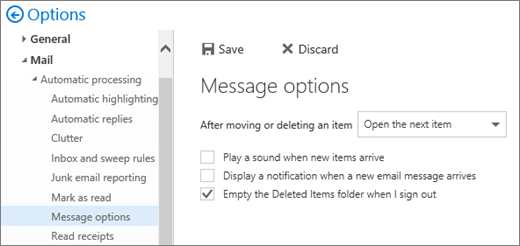
Related topics
Still need help?
The information in this article applies only to Outlook on the web. If you're not using Outlook on the web, choose from the following topics for help:
-
Outlook.com: Restore deleted email messages in Outlook.com
-
Outlook Web App: Recover deleted items or email in Outlook Web App
-
Outlook 2016, Outlook 2013, or Outlook 2010: Recover deleted items in Outlook for Windows
Note: If you're not sure which version of Outlook you're using, see: What version of Outlook do I have?










